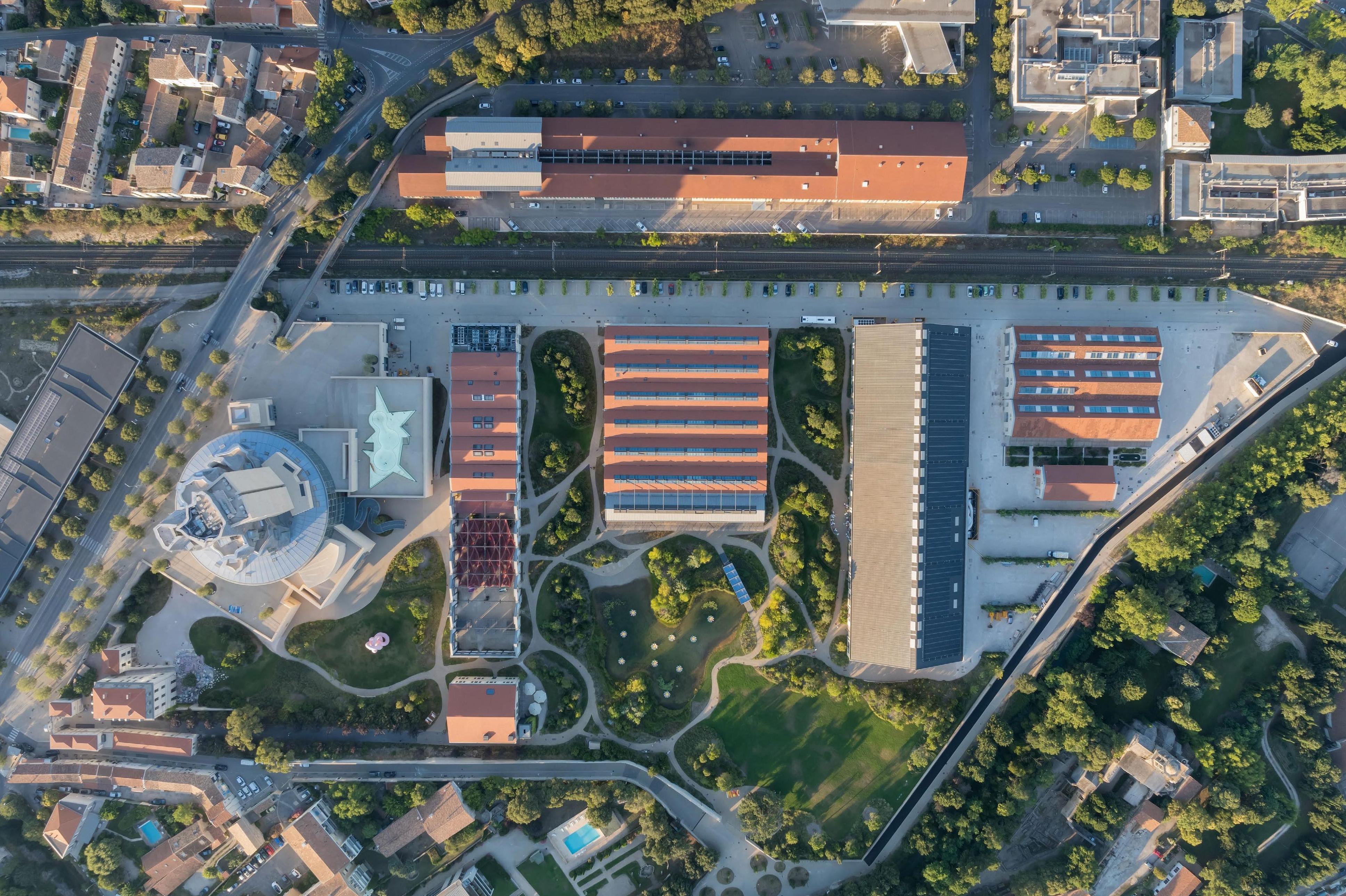Panorama architect Bas Smets is at present collaborating on a guide with Emanuele Coccia, a lecturer on the French analysis institute EHESS. The Italian-born thinker’s work centres on concepts of panorama and our connection to nature; his personal 2018 guide, The Lifetime of Vegetation: A Metaphysics of Combination, was modern in speaking concerning the elementary position of flora in our relationship with the world.
We met with Smets and Coccia to debate panorama, its that means and potential.
Emanuele Coccia and Bas Smets focus on
Wallpaper*: How did you two meet?
Bas Smets: I used to be in [artist] Philippe Parreno’s studio in Paris, and he instructed me, ‘You actually must learn this guide, The Lifetime of Vegetation.’ I invited Emanuele to be in dialog on the Palais de Chaillot in Paris, the place we had an exhibition in 2018. [Before the event] I took his guide to the Boboli Gardens in Florence, and I had a day to myself, underlining passages from it to type questions for our dialog.
Emanuele Coccia: That was the primary time we truly met, however you will need to say that we additionally noticed one another in a bar later, after which had dinner and an extended dialog. However we met due to Philippe, who’s a really shut pal of each of us.
(Picture credit score: ALEXANDRE GUIRKINGER)
W* Emanuele, are you able to clarify about your connection to panorama?
EC: After I was younger, I had agricultural coaching, which led me to work so much with subjects round ecology and biology. As a toddler, I needed I might turn into an architect, however I knew I couldn’t draw. So if you happen to put collectively these two parts, you arrive at panorama structure. I shortly realised, once I began to review ecology, that the phrase ‘ecologist’ must be changed by ‘panorama architect’, as a result of what we want is new panorama structure and never simply ecology. One of many greatest issues with ecological pondering right now is the separation of human and non-human. Every time we encounter an issue in ecology, we predict the answer is to go away non-humans alone. What now we have to do is type a very good relationship with the remainder of the species.
W*: So it’s about symbiosis?
EC: Not simply symbiosis. It’s additionally about forming house for us to stay collectively. This can be a good definition of panorama. Ecology usually thinks of the connection between people and non-humans by way of allotment gardens: everybody should have their very own house and keep the place they’re, in any other case they turn into an invasive species. Panorama structure, however, is the self-discipline that manages to discover a means for as many species as doable to coexist in a single territory. There are only a few practitioners who’re conscious of that, and Bas is one in every of them, which is why we instantly linked.
BS: I agree. I received into landscaping as I’ve at all times requested the philosophical query: stay on this planet? We have now all these life types, how will we share this planet? Landscaping for me just isn’t ornamental. It’s a systemic query. [French philosopher] Alain Roger wrote, ‘land turns into a panorama’. Panorama is an act of organising pure parts. It’s linked to actions that change the biosphere wherein we stay. Finally, it’s about biospheric pondering.
W*: It sounds just like the definition of panorama has modified over time.
BS: We stay in a time of disaster. Biospheric pondering is utilizing panorama tasks to make climates, perceive climates and organise microclimates, to search out options to local weather challenges. Panorama has come a great distance from backyard design. Hopefully, it helps us make cities extra resilient to local weather change.
EC: Nonetheless, there may be an embarrassingly low bar on our understanding of panorama, compared to structure, the place now we have produced an enormous quantity of theoretical pondering over time. Only a few panorama architects are writing; Bas is one in every of them. Consequently, the canon is extremely biased and restricted. There are not any publications speaking about thrilling panorama tasks taking place in numerous elements of the world. Faculties have to make panorama structure a much bigger self-discipline. This can be a big cultural tragedy. It’s a downside of coaching and a lack of expertise.
‘Panorama structure is the queen of science as a result of it helps us to contemplate nature as one of many greatest types of artwork on the planet’
Emanuele Coccia
BS: Emanuele and I usually say we have to begin a publishing home for panorama structure books. I began instructing at Harvard three years in the past. Panorama structure is a troublesome factor to show; you want a fundamental data of many issues, equivalent to pedology, geology, ecology, hydrology, meteorology and structure. It isn’t a subject you may be taught in 5 years. Working with residing materials is extremely advanced; you want expertise and to develop instinct. One other factor is that panorama structure has been uncared for for a few years by each architects and artists. So it’s not solely troublesome to turn into a very good panorama architect, however you might be additionally not checked out in the proper means. What we are able to do is territorial transformation, like [in designing the Luma Foundation’s Parc des Ateliers] in Arles, the place we made profound modifications with the assistance of crops. Vegetation are our brokers.
EC: Even from a authorized viewpoint, it implies a change in the way in which we do contracts, as with panorama structure, when the constructing mission ends is when the panorama one begins. It might last as long as ten or 20 years.

Parc des Atelier in Arles, by Bureau Bas Smets
(Picture credit score: Iwan Baan)
BS: There’s this attention-grabbing principle that landscaping modified its standing after the Second World Warfare. Earlier than the conflict, the modernist motion thought of panorama an important a part of its social programme and valued the significance of being outdoors. After the conflict, with the need to construct a considerable amount of housing in a really quick time, immediately all the eye went to constructing, and landscaping turned an afterthought. That’s not too way back.
EC: The issue is that now, having a roof over your head just isn’t sufficient. Cities right now are dying as a result of they weren’t inbuilt a means that frames your entire panorama, however solely take into consideration the human parts. We have to rewrite the idea of the town and remodel it right into a principle of the brand new planet. Each metropolis should turn into a sort of interspecies magnet, a spot the place your entire planet conspires to breathe higher. It’s a process that panorama structure ought to tackle.
BS: I believe panorama structure is, by definition, a collective intelligence. It’s biospheric science, every part is linked.

(Picture credit score: Iwan Baan)
W*: Panorama is linked to the local weather disaster, wellness and a way of place. What’s the most pressing downside for panorama architects to sort out for the longer term?
BS: With my college students, I don’t ask them to search out a solution to one thing; I ask them to pose a query. We current a metropolis and ask them, ‘What’s the most pressing factor to do?’ This manner, they be taught to outline the issue earlier than formulating a response.
EC: As most of us stay in cities, we have to rethink them. We have to invent types and buildings that enable nature to stay inside a metropolis. And we have to have a look at panorama structure as a creative house. Panorama structure is the queen of science as a result of it helps us to contemplate nature as one of many greatest types of artwork on the planet.
W*: Does this reframing embrace a way of ‘therapeutic’ nature and our planet?
BS: Landscaping just isn’t about restore. We’re half of a bigger ecosystem, and as a substitute of making an attempt to impose ourselves on it, we have to determine stay with it in a different way. It’s about understanding its systemic worth. For instance, we reworked a former desert [the park in Arles] into an unbelievable house the place a lot of species now thrive.
‘Panorama structure is, by definition, a collective intelligence. It’s biospheric science; every part is linked’
Emanuele Coccia
W*: Is it an equal relationship between people and different residing issues? We are able to manipulate the surroundings, however then we even have local weather change, nature’s response. The place does the panorama architect’s accountability lie by way of managing this relationship?
EC: I’m only a scholar, however I’d say that now we have to keep away from formulating the query in purely ethical phrases as a result of this fashion we’re giving an excessive amount of energy to humanity, who don’t have this energy, and we’re turning issues right into a query of guilt and advantage. For instance, we all know now that the Amazonian rainforest has been inhabited by many populations and has been largely formed by these populations. In contrast to what we used to assume, that is an city artefact, together with a lot of settlements. They didn’t ask themselves what their tasks had been, however they created an area that’s extra biodiverse than it was earlier than, probably the most biodiverse on the planet. That’s the energy of panorama structure, and we have to research it.
BS: It’s like being a caretaker. As Buckminster Fuller mentioned, we’re on the planet Spaceship Earth. It’s about making issues higher, and present situations are by no means last.

Visualisation of Bas Smets’ landscaping for Notre-Dame in Paris
(Picture credit score: TBC)
W*: Is there one thing that makes you are feeling optimistic concerning the future within the subject?
EC: That there are individuals like Bas, new figures, and intellectuals in panorama structure is unbelievable. This didn’t exist 40 or 50 years in the past. They’re reshaping the self-discipline.
BS: For me, it’s tasks like Arles: the second you convey again a systemic strategy, once you convey again soil, water, crops and are reenacting the looks of life on earth. We introduced water, then crops, and now animal life is coming again by itself. We tried to make calculations, in fact, however we by no means anticipated wildlife would come again so quick and so furiously. We have now 55 new species of birds, 20 of that are nesting right here. The second you faucet into the life drive, the regeneration is far quicker than something we might ever make as a human species. It’s a clear signal of hope.
Discover out extra about Bas Smets in our profile, and meet a few of the world’s most fun panorama architects within the Wallpaper* Panorama Architects’ Listing 2025
This text seems within the October 2025 Concern of Wallpaper*, accessible in print on newsstands, on the Wallpaper* app on Apple iOS, and to subscribers of Apple Information +. Subscribe to Wallpaper* right now
Supply: Wallpaper

